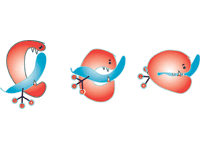Solid State Dynamics
Atoms and molecules in condensed matter are always moving. When the motion is sufficiently fast, nuclear spins respond to a spin hamiltonian that is averaged over the motion. When the motion is sufficiently slow, spins at different points on the motional trajectory respond to the spin Hamiltonian at that point. For intermediate rates of motion, a detailed statistical mechanical model is needed to describe the spin response. "Fast" and "slow" in this context refers to the magnitude of the relevant spin interaction, expressed in radians/sec (NOT Hertz).
In solid materials, spin interactions with their surroundings are generally described by second rank tensors. Restricted libration and rotational motions impart random time dependence to the relevant spin Hamiltonians, and the resulting spin response can then be computed by solving the stochastic Liouville equation for the spin density matrix. This is quite straightforward for the simple case of discrete jumps, at rate k, among N rotational "sites" , in absence of rf pulses. In this case, one gets to solve a set of N coupled first order differential equations for each density matrix element. Methods for doing this, including the computationally intensive task of summing over crystallite orientations for powder samples, are described in standard NMR texts. Restricted diffusive motion, modeled by coupled sets of second order partial diffferential equations, is computationally more intensive. However, this model is physically more reasonable and there is ample experimental evidence that it is more realistic than discrete jumps, especially in situations where the restricting potential function has broad, shallow minima. There are active research efforts in our group to improve the computational procedures needed to model diffusive motion, and to make such simulations accessible to non-specialists in NMR.
Solid state deuteron NMR is widely used for dynamic investigations. The dominant (1st order quadrupole) interaction is is small enough to permit easy detection, and since the electric field gradient tensor in a deuterated organic molecule generally has nearly cylindical symmetry with the largest (unique) component along the C-D bond direction, analysis of the spin response to various pules sequences providews direct, quantitative information about C-D bond reorientations. Moreover, the method works equally well for single crystal samples, polycrystalline powders, and amorphous glassy materials. A large part of our research program is devoted to using solid state deuteron NMR to characterize dynamics in complex materials.
 For example, in the artistic(?) rendition of enzyme action shown, one can imagine a deuterated methyl group attached to the banana-shaped substrate. The methyl group motion could be modelled as 3-site jumps around the attachment axis, which itself undergoes sudden reorientations upon binding in the active site of an enzyme.
For example, in the artistic(?) rendition of enzyme action shown, one can imagine a deuterated methyl group attached to the banana-shaped substrate. The methyl group motion could be modelled as 3-site jumps around the attachment axis, which itself undergoes sudden reorientations upon binding in the active site of an enzyme.
The time scales for such complex motional processes can vary from picoseconds to multiple seconds. Remarkably, this enormous range of time scales is fully accessible experimentally by using the appropriate combination of pulses sequences and data acquisition procedures. Methods used routinely in our laboratory are summarized below.
| Dynamic Techniques in Solid State Deuteron NMR | ||
| Experiment | Pulse Sequence | Time Scale |
| Stationary Line Shape | quadrupole echo | 100 ns - 0.1 ms |
| Spin Lattice Relaxation (T1Z) | inversion recovery | 1 ps - 1 ns |
| Quadrupole Order (T1Q) | broadband Jeener-Broekaert | 1 ps - 1 ns ; 1-100s |
| MAS/OMAS | one-pulse | 10 ns - 1 ms |















